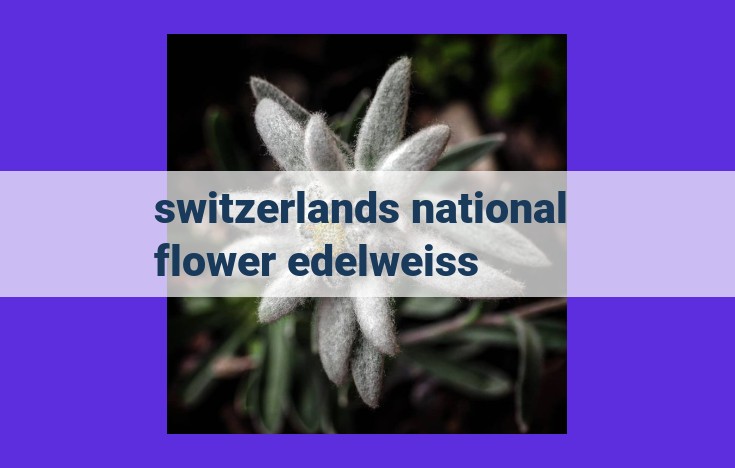The Edelweiss, Switzerland’s national flower, is a perennial herb with silvery leaves and star-shaped white flower heads. As part of the daisy family, it belongs to the Asteraceae family, with its scientific name being Leontopodium alpinum. Native to European Alps, this alpine flower symbolizes courage, purity, and resilience, and is culturally significant in Swiss folklore and craftsmanship.
Edelweiss: The Enchanting National Flower of Switzerland
Nestled amidst the towering Swiss Alps, there blooms a flower of rare beauty and profound significance. The Edelweiss, Switzerland’s national emblem, captivates hearts with its delicate petals and a captivating story that has been woven into the fabric of Swiss culture for centuries.
A Symbol of Purity and Resilience
As the sun’s rays dance across the alpine meadows, the Edelweiss stands as a testament to the strength and resilience of the Swiss spirit. Its star-shaped white flower head, a beacon of hope among the rugged peaks, symbolizes the enduring values of purity, courage, and unwavering determination.
A Botanical Marvel
The Edelweiss belongs to the daisy family, boasting a scientific name, Leontopodium alpinum, that translates to “lion’s paw on the mountain.” Its silvery leaves, adorned with soft white hairs, create an ethereal glow that sets it apart from its alpine companions.
A Protected Treasure
Although the Edelweiss thrives in the harsh alpine environment, it remains a vulnerable species. As a result, it is designated as Least Concern by the International Union for Conservation of Nature (IUCN). Conservation efforts aim to protect its delicate habitats and ensure its survival for future generations.
A Swiss Legend
In the heart of Swiss folklore, the Edelweiss holds a special place. Legends tell of brave men scaling treacherous cliffs to pluck this precious flower as a symbol of their love and devotion. Its rarity and beauty have made it a cherished gift, a symbol of love, and an embodiment of the Swiss spirit.
Experience the Enchantment
If you find yourself among the Swiss Alps during the blooming season from July to August, take a moment to admire the ethereal beauty of the Edelweiss. Marvel at its delicate petals, inhale its subtle fragrance, and let its story of courage and resilience inspire you.
Edelweiss: A Perennial Herb from the Daisy Family
Plant Type
The Edelweiss, a symbol of Switzerland and an alpine beauty, belongs to the plant family *Asteraceae*, commonly known as the daisy family. This vast family boasts a diverse range of plants, connected by shared characteristics such as daisy-like flowers and composite flower heads. Edelweiss, classified as a perennial herb, is no exception.
A perennial herb is a non-woody plant that lives for more than two years. Unlike trees and shrubs, herbs do not develop permanent woody stems. Edelweiss typically forms low-growing clumps and adorns alpine meadows with its silvery foliage and star-shaped white flower heads.
The plant kingdom is a vast and complex tapestry, and Edelweiss occupies a unique place within it. Its classification as a perennial herb in the daisy family further enriches the diversity of plant life and highlights the intricate relationships within the natural world.
Scientific Name:
- Explanation of the scientific name Leontopodium alpinum, its meaning and relevance to the plant’s characteristics.
Scientific Name: Leontopodium alpinum
The scientific name of the Edelweiss, the revered national flower of Switzerland, is Leontopodium alpinum. This intricate moniker holds profound meaning, reflecting the plant’s unique attributes and alpine habitat.
Leontopodium derives from Greek and translates to “lion’s paw.” This aptly describes the plant’s striking flower head, which resembles a velvety paw adorned with silvery hairs. Just like a lion’s paw conveys strength and nobility, the Edelweiss has become a symbol of courage and resilience in Swiss culture.
Alpinum signifies the plant’s alpine environment. Endemic to the European Alps, the Edelweiss thrives in the harsh conditions of high-altitude meadows and rocky outcrops. Its ability to withstand extreme cold and altitude attests to its remarkable hardiness.
The scientific name, Leontopodium alpinum, serves as a testament to the Edelweiss’s distinctive appearance and its adaptation to its alpine home. The plant’s silvery leaves, woolly flower head, and preference for mountainous terrain all contribute to its allure and its significance as a symbol of Swiss pride.
Family: Asteraceae
The Edelweiss belongs to the vast and diverse Asteraceae family, also known as the daisy family. Asteraceae is one of the largest plant families in the world, boasting over 32,000 species across nearly 1,900 genera.
Common Characteristics
Daisy-like Flowers: Asteraceae plants are renowned for their distinct flower heads, which resemble daisies. These flower heads are composed of two types of florets: ray florets and disc florets. Ray florets form the outer ring of the flower head, while disc florets occupy the central portion.
Composite Flower Heads: The flower heads of Asteraceae plants are technically classified as composite flower heads. This means that each flower head is actually a collection of individual flowers, each with its own ovary and style.
The Edelweiss in the Asteraceae Family
Within the Asteraceae family, the Edelweiss belongs to the subfamily Asteroideae and the tribe Gnaphalieae. These classifications further refine the characteristics of the Edelweiss, such as its silvery leaves and star-shaped white flower heads.
The Asteraceae family is a treasure trove of botanical diversity, with species ranging from the humble dandelion to the magnificent sunflower. By situating the Edelweiss within this family, we appreciate the plant’s kinship with a vast array of other flowering wonders.
Genus: Leontopodium and the Edelweiss’s Striking Symbolism
The genus Leontopodium derives its intriguing name from the Greek words “leon,” meaning “lion,” and “podion,” signifying “little foot.” This etymology aptly reflects the distinctive shape of the Edelweiss‘s flower head, reminiscent of a lion’s paw.
The flower head is composed of numerous tiny star-shaped florets, forming a dense, woolly cushion surrounded by silvery-white bracts. These bracts resemble the petals of a flower, creating an illusive appearance that has captivated nature enthusiasts for centuries.
Symbolic Significance
Beyond its physical characteristics, the Leontopodium genus holds deep cultural significance. The Edelweiss, in particular, is Switzerland’s national flower, embodying the nation’s courage, purity, and resilience. This symbolism is deeply rooted in the flower’s ability to thrive in harsh alpine environments, withstanding extreme weather conditions and rocky terrain.
In Swiss folklore, the Edelweiss is often associated with true love. It is said that a man who risked his life to retrieve an Edelweiss from a steep mountainside demonstrated his unwavering devotion to his sweetheart. This legend has contributed to the flower’s popularity as a romantic symbol.
Conservation Considerations
Despite its iconic status, the Edelweiss faces potential threats from habitat loss, climate change, and over-collection. As a protected species, it is crucial to exercise restraint when seeking out and admiring these delicate flowers in the wild.
By understanding the genus Leontopodium and the cultural significance of the Edelweiss, we can appreciate the beauty and symbolism of this enduring alpine treasure. It serves as a reminder of nature’s resilience and the importance of preserving our precious natural heritage for generations to come.
Species
The Edelweiss, scientifically known as Leontopodium alpinum, belongs to the alpinum species, one of the 50 species within the Leontopodium genus. As the name suggests, alpinum originates from the alpine meadows of Europe, where it thrives in mountainous habitats. These high-altitude grasslands, often found in the Alps, provide the perfect environment for the Edelweiss to flourish.
Within the plant kingdom, the Edelweiss holds a distinct taxonomic position. It is classified as a perennial herb, meaning it completes its life cycle over multiple growing seasons. As a member of the Asteraceae family, it shares characteristics with other daisy-like plants, such as a composite flower head made up of numerous tiny florets.
The Edelweiss’s unique scientific name, Leontopodium alpinum, offers insights into its physical attributes. Leontopodium stems from Greek and translates to “lion’s paw,” a reference to the plant’s distinctive flower head shape. Alpinum, on the other hand, signifies its alpine habitat, highlighting its preference for high-altitude environments.
The Common Name: Edelweiss
Edelweiss, the national flower of Switzerland, derives its name from the German words edel (noble) and weiß (white). True to its name, the Edelweiss exudes an aura of nobility and purity. In German, it is known as Edelweiß, while the French refer to it as Étoile des Alpes (Star of the Alps). In many languages, the Edelweiss’s common name reflects its star-like appearance and alpine habitat.
The etymology of the Edelweiss’s name speaks volumes about the plant’s cultural significance. Its association with nobility stems from its rare beauty and its resilience in the face of challenging alpine conditions. The flower’s white color symbolizes purity, representing the unblemished nature of Switzerland.
Over the centuries, the Edelweiss has become deeply entwined with Swiss folklore and national identity. It has featured prominently in jewelry, embroidery, and folk songs, serving as a symbol of love, devotion, and courage. Its delicate beauty and resilient nature have made it an enduring symbol of the Swiss spirit.
Native Range and Habitat: The Edelweiss’s Alpine Haven
Nestled within the European Alps and their lofty neighbors, the Edelweiss thrives in an alpine sanctuary. This resilient bloom is not for those who seek comfort; it prefers the high altitudes, where rocky outcrops and vast alpine meadows are its playground. But it is here, in this rugged terrain, that the Edelweiss truly flourishes, painting the landscape with its delicate white hues.
As if plucked straight from a fairy tale, the Edelweiss calls alpine grasslands its home. Here, it shares space with hardy wildflowers and fragrant grasses, forming a vibrant tapestry of wildflowers. The plant’s silvery leaves, covered in a soft down of white hairs, shimmer in the sunlight, creating a shimmering effect that adds to its ethereal charm.
Though it prefers alpine meadows, the Edelweiss will venture onto rocky outcrops, where it** clings tenaciously** to the stone, its roots seeking nourishment in the cracks and crevices. This ability to thrive in harsh conditions is a testament to the Edelweiss’s resilient nature, a trait that has made it the beloved symbol of Switzerland.
Physical Characteristics:
- Detailed description of the Edelweiss’s physical features, including its height, silvery leaves covered with white hairs, and star-shaped white flower heads with a woolly center.
Physical Characteristics of the Edelweiss, Switzerland’s Enduring Symbol
Beneath the azure skies of the Swiss Alps, the Edelweiss unfolds its ethereal beauty. This alpine treasure, Switzerland’s national flower, captivates with its silken silvery leaves and star-shaped white flower heads.
Standing 8-12 inches tall, the Edelweiss adapts to its rugged environment with a compact, cushion-like form. Its leaves, oblong and covered in a dense layer of white hairs, glisten like tiny mirrors, reflecting the warmth of the sun. These fine hairs create a protective layer that shields the plant from cold temperatures and excessive sun exposure.
The focal point of the Edelweiss is its star-shaped flower head. The white woolly center, resembling a cushion of snow, is surrounded by eight silvery bracts that resemble delicate paper. These bracts form a star-like pattern, giving the flower its ethereal beauty. The Edelweiss blooms from July to August, adding a touch of alpine elegance to the rocky landscape.
Flowering Period and Pollination: A Tale of Alpine Blooms and Busy Wings
Amidst the rugged peaks of the Swiss Alps, Edelweiss, the nation’s beloved flower, unfurls its delicate petals from July to August. This pristine bloom, a symbol of purity and resilience, undergoes an enchanting journey of pollination that unfolds in the heart of the alpine meadows.
The Edelweiss’s flower head, a star-shaped masterpiece, exhibits a remarkable adaptation for attracting pollinators. Its white, woolly center, reminiscent of a fluffy cushion, emits a sweet fragrance that wafts through the mountain air. As butterflies and moths flutter by, they are drawn to this irresistible scent, seeking nourishment from the flower’s nectar.
Upon landing on the flower head, these winged visitors unwittingly become the architects of the Edelweiss’s reproductive success. As they probe their delicate tongues into the flower’s depths, they inadvertently collect pollen grains on their bodies. These tiny, dust-like granules hold the key to the Edelweiss’s future generations.
As the insects visit multiple Edelweiss blooms, they inadvertently transfer the pollen from one flower to another. This act of cross-pollination ensures genetic diversity and enhances the plant’s ability to adapt to changing environmental conditions. Through this harmonious partnership, butterflies and moths play a vital role in the continuation of the Edelweiss’s lineage in the alpine realm.
Symbolism:
- Cultural significance of the Edelweiss as the national flower of Switzerland, representing courage, purity, and resilience. Discussion of its use in traditional Swiss jewelry, embroidery, and folklore.
Symbolism: The Edelweiss, A Cultural Icon
The Edelweiss, Switzerland’s beloved national flower, is not just a symbol of the country’s natural beauty but also of its cultural heritage. Woven into the tapestry of Swiss tradition, this alpine bloom holds deep significance.
In Germanic folklore, the Edelweiss, with its star-shaped flower head, is associated with courage and purity. This symbolism is rooted in its resilience, as it thrives in harsh alpine conditions. The white hairs covering its leaves are said to represent the purity of the snow-capped mountains.
Over centuries, the Edelweiss became a cherished symbol of courage and resilience for the Swiss people. Its image can be found in traditional Swiss jewelry, often adorned by men as a testament to their bravery. Women have long embroidered it onto their clothing, using its starry shape as a symbol of hope.
The Edelweiss’s cultural significance extends beyond jewelry and embroidery. In Swiss folklore, it is said that a man who gifts an Edelweiss to a woman is offering her his heart. Its white, silvery petals represent the purity of his love.
As a symbol of Switzerland’s national pride, the Edelweiss can be found in a variety of forms, from postage stamps to souvenirs. Its image evokes the country’s rugged mountains, its rich history, and the indomitable spirit of its people.
Throughout the years, the Edelweiss has become a cherished emblem of Switzerland, a flower that carries the weight of cultural heritage and national identity. As a symbol of courage, purity, and resilience, it continues to inspire the Swiss people and captivate visitors alike.
Protection Status of Edelweiss: A Balancing Act between Nature and Human Influence
The Edelweiss, Switzerland’s national flower, stands as a symbol of purity and perseverance amidst the rugged peaks of the Alps. Least Concern under the IUCN Red List, this endangered species faces various threats that require our attention.
One significant threat is habitat loss. As human activities expand, the Edelweiss’s pristine habitat in alpine meadows and rocky outcrops is shrinking. Infrastructure development, tourism, and agricultural encroachment have fragmented these natural sanctuaries, creating isolation and reducing the gene pool.
Climate change poses another challenge. Altered precipitation patterns and rising temperatures can disrupt the Edelweiss’s growth cycle, making it difficult for the plant to survive in its native environment. Increased droughts and heat stress can lead to dehydration and reduced seed production.
Over-collection is a pressing concern. Tourists and plant enthusiasts alike are drawn to the beauty of the Edelweiss, leading to illegal harvesting. Coupled with slow population growth, over-collection depletes available plants, affecting pollination and genetic diversity.
To ensure the survival of this national treasure, conservation efforts are paramount. Protected areas have been established to safeguard its habitat, and awareness campaigns encourage responsible tourism and sustainable harvesting. Research and scientific studies monitor populations and assess the impacts of threats, guiding conservation strategies.
By understanding these threats and supporting conservation initiatives, we can preserve the Edelweiss for generations to come. Its resilience and beauty are a testament to the delicate balance between nature and human influence. Let us work together to ensure this alpine icon continues to grace the Swiss Alps, enchanting visitors and inspiring awe for years to come.




